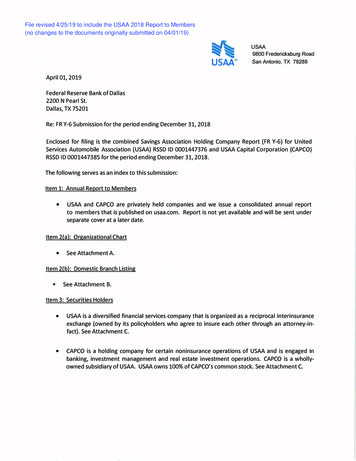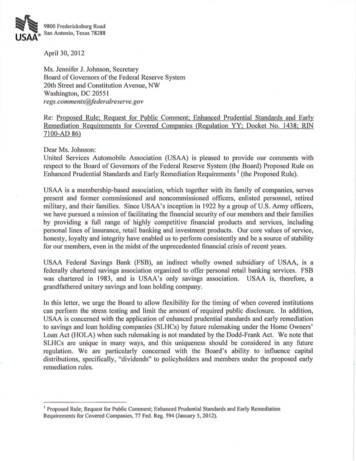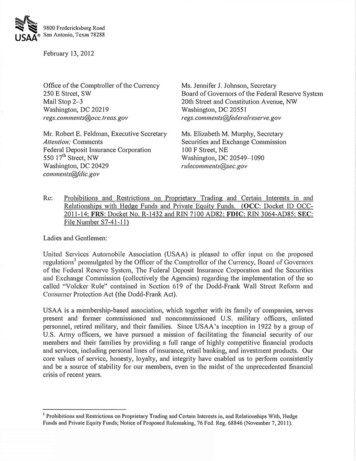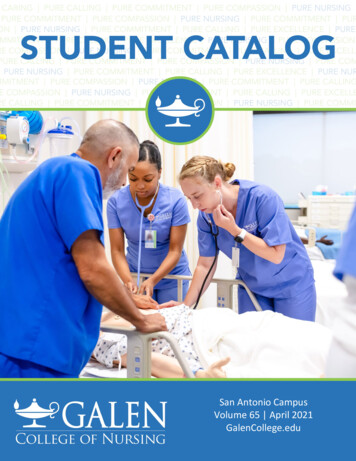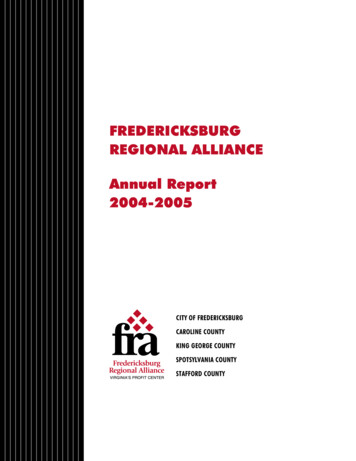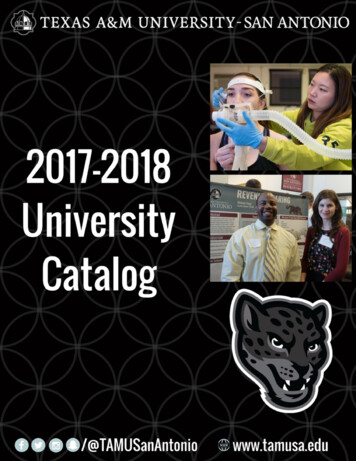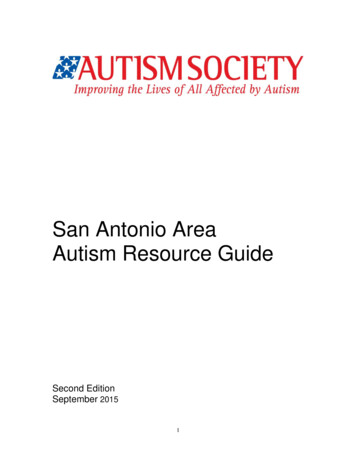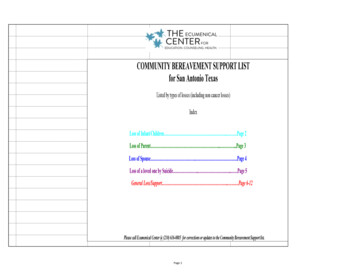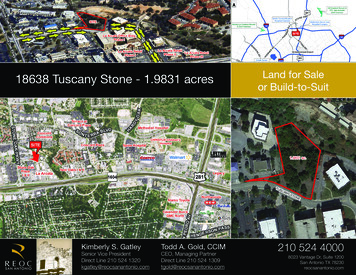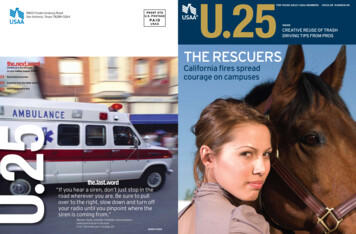
Transcription
For young adult USAA membersIssue 59 SUMMER 08PRSRT STDU.S. POSTAGE9800 Fredericksburg RoadSan Antonio, Texas 78288-0264PA I DUSAAinsideCreative reuse of trashDriving tips from prosThe RescuersCalifornia fires spreadcourage on campusesComing up in the fall issue(in your mailbox August 2008)Rock-band economicsGroceries from the dollar store?How to avoid extra fees“If you hear a siren, don’t just stop in theroad wherever you are. Be sure to pullover to the right, slow down and turn offyour radio until you pinpoint where thesiren is coming from.”Welcker Taylor, volunteer firefighter and emergencymedical technician in VermontFrom “Drive like a pro” on page .2066584-0508
summerA magazine for young adultUSAA membersFriendor foe?EditorCarol BarnesDesignKym Abrams Design Inc.Those environmentally friendly compactfluorescent light bulbs might not be sofriendly, after all, especially when they break.The bulbs contain mercury, a toxic liquidmetal that can be dangerous even in smallquantities because it can be inhaled orabsorbed through the skin and damage thecentral nervous system. Small amountsalso can build up in the environment ifthe bulbs are thrown in the garbage.When you clean up broken pieces,follow these recommendations fromContributorsSarah Inez Levy, Robert Lopez,Sean McCollum,Jennifer Plummer, Sean Price,Deborah Price, Roger Slavens,Stephanie Thurrott,Stephen Viscusi, June Walbert,Barbara Alden WilsonU.25 Editorial BoardAmy Anderson, Derrick Baylor,Derek England, Alana Herro,Sarah Hitchcock,Amanda Hoff, Emily O’Dell,Bill Oram, Jeanette Prather,Katherine Raney, Josh Rhoten.03 b its bytesUp-to-date news youcan use.06 career coachProductionDavid Gunn, Lisa SeversonYouth Media DirectorJulie FinlayU.259800 Fredericksburg Road, E-1-ESan Antonio, Texas 78288-0264Telephone: (800) 531-8013Fax: (210) 498-8754E-mail: U25@usaa.comthe Environmental Protection Agency.Answers to your questionsabout work life1. Before cleaning up, open nearbywindows and leave the room for at leastON T HE COVE R - CAItl i n StEI m l e . PHOTOG RAPH Y by k ev i n Lo c k 20 0 815 minutes. Some mercury vapor could.07 T ests of firebe in the air.5 perspectives from the Californiawildfires2. Protect your hands with disposablerubber or plastic gloves. Scoop up the bulb.14 R ecycling by designfragments using stiff paper or cardboard.Do not use a vacuum cleaner, which could stirWant to receiveU.25 at a differentaddress?E-mail your new address toU25@usaa.com. Please include yourname and USAA member number.Visit U.25 online atusaa.com/u25.18 road.scholarInformation you need behindthe wheel.22 start smartUSAA programstailored for youU.25 is published four times a year for young adult USAA members. USAA also publishes U Mag for young members, U-TURN magazine and a weekly podcast for teen members, usaa.commagazine for members beginning their financial journey, and USAA Magazine for adult members. USAA is a member-owned financial services group that provides a complete line ofinsurance, investment, banking, and other services to millions of members worldwide. Material in this magazine may not be reproduced, stored in a retrieval system, or transmitted in any formor by any means (electronic, mechanical, photocopying, or otherwise) without permission from the publisher. Copyright 2008 by USAA. All rights reserved. U.25 is a registered trademarkof USAA. To order additional copies, submit writing samples, or request reprint permission, contact U.25, USAA, Attn: Youth Media, 9800 Fredericksburg Road, E-1-E, San Antonio, Texas78288-0264; (800) 531-8013.02U.25Summer2008P h oto g rap h y by isto c k p h oto a n d p u n c h sto c kIdeas for reusing your stuffup the mercury in the air.3. Use a damp paper towel to make sure all thepieces are picked up.4.Place all fragments and materials used in thecleanup in a plastic bag. Place the sealed bag insideanother plastic bag and seal it as well. Place thebag in an outside trash bin until you canrecycle. Don’t toss your burned-out bulbs inthe regular trash, either. When they build upin landfills, the mercury they contain canFor recycling options, contact your localmunicipal solid waste agency or go tohttp://www.epa.gov/bulbrecycling/or earth911.org.leak into the soil and water supplies andpoison fish and other wildlife.U.25Summer2008.03
Have plastic, will travelIf you’re planning to travel this summer, make sure your credit anddebit cards are ready by taking action on these four tips.tilbil splIf you want to show your appreciation to someone servingyour community or country, try this simple gesture thatsays “thank you” in American Sign Language. Place yourhand on your heart like you’re saying the “Pledge ofAllegiance,” then pull your hand down and out, bending atthe elbow (not the wrist), stopping for a second at aboutyour belly button with your hand flat, palm up, angledtoward the person you’re thanking.Gratitudecampaign.org originally promoted thegesture to thank U.S. military members with auniversally recognizable sign.Cool gasDuring hot summer months, fillingup your gas tank at night or inthe morning when the weather’scooler can save money, accordingto scientists at the University ofArizona. Just like water, gasolineexpands in the heat. Hot gasper gallon has less densitybecause it has expanded.That means it provides yourcar with slightly less energythan a cool gallon.04U.25Summer2008P h oto g rap h y by isto c k p h oto a n d p u n c h sto c kSign of thanks Nearly half of allAmericans saythey lose, misplaceor don’t knowwhat happened to 2,340 each year.Source: Visa USA survey1. Let your bank or credit card company know where you’llbe traveling. This could lessen the risk of the bank blocking yourcard when you use it away from home.2. Photocopy both sides of your cards and store the copieswhere you can access them if the originals are stolen. This couldbe with a relative at home, but not in your wallet. The photocopiesare useful for reporting the theft/canceling charges because theycontain all of the card information and important contact numberson the back.3. Understand the fees your credit and debit card providerscharge for cash advances, withdrawals, and foreign transactions.Make sure your PIN is only four digits and all numbers. Manyoverseas ATMs accept only four-digit PINs, and their keyboardshave only numbers.4. Check out your credit card and insurance companies’travel insurance policies to see whether they cover the costs oftrip cancellations or emergency medical care while you travel. Youmight want to purchase travel insurance to fill in the gaps.Be sure to discuss how the bill will be paidwhen dining out.A DateWhoever does the asking does the paying.It’s OK to offer to go dutch or split the bill.With a friendPay for yourself, or take turns picking upthe tab.Group of friendsAsk for separate checks as soon as you’reseated.For a birthday celebrationDecide ahead of time whether the groupwants to pay for the birthday person. Makesure everyone knows and agrees.Source: Lizzie Post, author of “How Do You Work This Life Thing?”U.25Summer2008.05
Tests off requestions.answersJoin the teamIf you ask people what they reallywant in a co-worker, the majoritywill say teamwork. If you want tobe a true team player, here areways to shine. Carry your weight. Do your jobpromptly and well. Accept suggestions. Don’t be aprima donna. Have an upbeat attitude. Share credit. Don’t hog thespotlight. Don’t buck the lead person’sauthority.I see job fairs advertised around How did they get their jobs with themy college. Are they worthcompanies?Got a question for our career pro?E-mail U25@usaa.com. We’ll answera few in each issue of U.25.For recent college graduates,working for a temporaryattending? How do I make myself stand How long have they worked for theirstaffing agency is a logical first stepout? It seems like it would be hard tocompanies?into the working world. In fact, thesemake an impression at one.Ask for their business cards, thenassignments can lead you to industriesFair dealfollow-up with a thank-you note toand job positions you might not haveeach recruiter. Realistically, don’tthought about or been exposed to.go to a job fair expecting a job orThey are a great introduction to whatJob fairs are important becauseinterview. You’ll need to follow up onit’s like to work in an office or businessthey help you learn aboutyour own. However, job fairs are greatenvironment. On your résumé, explainpotential employers. It is true they areplaces to get started on a job search.your temp job and your duties.crowded, and it is difficult to separateyourself from the pack. However,.06you can make yourself stand out byWhile I’m looking for a full-timegetting to know each recruiter. To getjob, I was considering workingconversations going, here are a couplefor a temp agency. Is this a goodof questions you can ask the recruiters:idea? How will a temp job look on my Where did they graduate fromrésumé? Where do I go to find a goodcollege?temp agency? Where are they from originally?Temp timerU.25Summer2008To find temporary staffingagencies, check your local phonedirectory or Google.Career expert Stephen Viscusi appears onABC’s “Good Morning America” and thenationally syndicated radio show “On theJob.” He also is the author of “BulletproofYour Job.”P h oto g ra p h y BY G e tty i m ag es a rc h i v eU.25’s workplace expertanswers your questionsabout job fairs and workingtemp jobs.In just 22 days last fall, wildfires blackened more than 500,000 acres,burned 2,200 homes, and killed 10 people in Southern California. Asflames skirted area universities and forced dorm evacuations and classcancellations, the crisis ignited courage, generosity, and ingenuityacross the region’s campuses. The following five college studentsexperienced the fires firsthand. by Sean McCollumU.25Summer2008.07
“It was humbling tointerview people whohad lost their homes andeverything they owned.”Brandon OpLiger, 22,firefighterWhile others fled the wildfires, BrandonOpliger was speeding toward them. Opligerand his Temecula-area U.S. Forest Servicefirefighting crew spent three weeks fightinga fearsome nightmare of scorching heat.Besides using water and other firefightingtools, they relied upon their own adrenalineto beat back the flames. They perseveredon only snatches of sleep. Coincidentally,the political science and biology major atthe University of California, San Diego, hadtaken the fall semester off to earn extramoney. Opliger, who comes from a long lineof firefighters, found himself engulfed in thefamily tradition.HIS responsibilitYOur job was structure protection, and weprotected the homes as best we could.His perspectiveHIS memorable momentOur crew stopped at a restaurant to grab abite. A man tossed a 100 bill on our tableas a thank you. We tried to give it back butthe guy refused. There is something abouta crisis like this that brings the communitytogether.P h oto g rap h y BY K evi n Lo c kIt’s hard when you see a roof catch fire.Check out Nguyen’sblog and video@usaa.com/u25.Charles Nguyen, 20, campus newspaper eDItor“You know someone islosing everything theyown. And sometimesyou have to make toughchoices about whichhouses to defend. It’snot a good feeling. Butthe feeling you get whenyou save one helpsmake up for it.”While neighbors voluntarily packed up and droverequired to leave. By chance, I had checked outoff, Charles Nguyen, 20, stayed put at his housea video camera for a class project. I was due toin Poway, Calif. Not in immediate danger butreturn it, but with the campus closed I used itwith ash falling around him, the editor-in-chiefinstead to report on the fire.of The Guardian, the University of California,San Diego, campus newspaper, stayed with theHIS memorable momentstory and rallied his newspaper staff to keep theI remember seeing things that didn’t fitnews flowing.together. I remember driving past a militarybarricade on Espola Road in Poway, seeingHIS responsibilityfederal authorities posted in a residentialI led a team of student reporters at the campusarea. The neighborhood was ghostly quiet, butnewspaper to cover the story. We wrote shortthe winds were picking up speed and creatingnews blurbs and updates that helped thean eerie sound. A staffer and I trekked up anUCSD community stay current about the fires,ash-covered mountain to get footage of a fewclosures and other news.helicopters. It was astonishing to see residentiallife, such as Poway High School and the Poway.08U.25Summer2008His perspectiveCenter for the Performing Arts, so near aMy neighborhood came close to getting themountain that had been burned by the flamesevacuation announcement, but I was neverjust hours before.U.25Summer2008.09
Megan LusTIgson, 24, student internAs the fires spread, Megan Lustigson mannedto get the Emergency Operations Centerthe phones at the San Diego County Office ofup to speed. More than 200 people were inEmergency Services, a brain center for theaction coordinating the response — includingfire’s emergency response. At the same time,representatives of the various emergencyshe was keeping tabs on the threat to herservices, plus the American Red Cross,parents’ home in nearby Scripps Ranch. ItNational Guard, and other military teams.“The experience taught me to neverunderestimate the combination of fire andwind. Basically, I thought fires like thesehappened only in rural mountains or on windyplains. I learned that fires can happen anywhereand saw how fire jumps dozens of feet in asecond.”was an eye-opening experience for thegraduate student who is earning herHER memorable momentmaster of science degree in public healthWhen the fire threatened my parents’ house,with a specialization in global emergencythey were a little calmer than I was andpreparedness and response at San Diegohad an evacuation plan. They had all theirState University.important papers — passports, mortgage, etc.— in one place. We packed up family picturesHER responsibilityand antiques. The television was on in theI was a receptionist and information runner,background, and the broadcast reports madegetting information to the people who neededme uneasy. I actually felt calmer when I gotit to open up local assistance centers.back to the office because there I could seewhat was really going on. By the next day, theHER perspectivethreat had passed and my parents were backOn a Sunday afternoon, we were called inhome safe.P h oto g rap h y BY K evi n Lo c k“I learned firsthand the powerof teamwork — how everyonein crisis management has arole and how everyone workstogether with one goal inmind: the safety of the public.”Nathan RIx, 21, resident advisorPepperdine University senior Nathan Rix went to bed to theHIS perspectivesound of news reports warning that dry conditions and highI’m from New Jersey where wildfires are not that big a deal,winds were creating extreme fire danger. At 6 a.m., a call fromso I was wondering how bad it could be.campus security woke him up. The fires were threatening thecampus. It was time for Rix to go into action.HIS responsibility.10U.25Summer2008HIS memorable momentI woke up everyone after we got the word to relocate. Beingearly on a Sunday morning, a few people were face-plantedMy job was to alert all residents in student housing and get themon the beds after a late Saturday night. I had to go back toto safety at the campus field house. I handed out fire masks, maderouse a couple of them. But once they walked out and sawlots of sandwiches, and helped calm the fears of students andthe smoke and flames, they didn’t need a lot of convincingtheir parents.to leave.U.25Summer2008.11
warn ngs gnsCAItlin StEImle, 20,volunteerWhen Caitlin Steimle heard the call for volunteersto help round up horses threatened by the flames,“I saw the truth in how one person can make adifference, but that people working togetherfor a greater goal is even more powerful.”she hitched her horse trailer to her pickup truckand rode to their rescue. A member of the Bootsand Saddles Club, the equine major at PierceCollege spent the next couple of weeks helpingOn the first day of last fall’s wildfires, a newwith the care and feeding of more than 150trend lit up cell phones around the Pepperdinehorses evacuated from threatened areas.University campus. As smoke masked theMalibu views, text messages and Reverse 911HER responsibilitycalls informed students, faculty, and staffI used my truck and trailer to evacuate 12 horsesto relocate to safe areas on campus. If offfrom threatened areas. I also helped check incampus, they were warned to steer clear. Laterhorses at the evacuation center.messages provided updates on the fires andnotifications of class cancellations.HER perspectiveSuch emergency alert systems are quicklySome horses were terrified. A fight-or-flightbecoming prerequisites at colleges andresponse in a 1,200-pound animal can be a fright.universities from St. John’s University in NewOne stepped on my foot and broke my big toe, butYork to the University of California, San Diego.I kept limping around.Spurred in part by last year’s shootings atVirginia Tech, hundreds of schools have rapidlyHER memorable momentupgraded their capability to alert people toMy friend, Tiffany, and I drove up to Topangadanger. The messages also advise recipientsCanyon to evacuate a pony and a horse. We goton how to respond — whether to sit tight orthere around midnight. The road was crazy steep,get moving. Pepperdine students credit theand we could see fires burning a little too closeautomated updates with quelling rumors andfor comfort. The animals took almost an hour-calming fears during the fires.and-a-half to load, and I had all these flashlightsLike Pepperdine’s alert system, most ofset up so we could see. There was no place to turnthese networks incorporate text messaging,around so I had to back the truck and trailer upReverse 911 calls to cell phones and landlines,this narrow road, with just a couple of inchese-mail and instant-messaging, and canon either side in some places. It was thegenerate faxes. UCSD also features publicscariest thing I’ve ever done.address speakers to broadcast voice alertsduring an emergency situation. “We designedthe system to be redundant,” says PhillipVan Saun, manager of emergency services atUCSD. “During an earthquake, for example,cell phone towers may come down or the cellsystem may be overwhelmed with calls,” hesays.Users register their contact informationonline, and campus officials are combiningeducation and promotion to get people to signup. But the emergencies themselves seem tobe the best advertising. Van Saun notes that8,000 to 11,000 after the wildfires threatenedtheir campus.To inquire about emergency alert systemsin place at your university, check youruniversity’s Web site or contact the campussecurity office.12U.25SUMMER2008P h oto g rap h y BY K evi n Lo c kthe number of registrants at UCSD leapt fromU.25Summer2008.13
By Stephanie ThurrottYou’ll need- used water ski, snow board, or skate board (available at used sportinggoods stores for approximately 25)- shelf brackets with screws to hold the ski or board to the wall (Size willdepend on which item you use for the shelf. If in doubt take the shelfmaterial to the hardware store and get advice.)- screwdriver or drill- level to make sure the shelf is straight- stud finder to make sure the brackets can support the shelf’s weight- pencilHow to make1. Locate the spot you’d like to place your shelf and, using the level, drawa straight line with a pencil.2. Use the stud finder to identify the studs and mark their location with thepencil on the line.3. Install the shelf brackets with the drill or screwdriver, making sure theThink twice. The trash you’re getting ready to toss could takeon a second life.Overflowing landfills and shrinking bank accounts are givingeveryone from corporations to college groups an incentive tobe inventive with garbage. After championship games, majorsports leagues are sending mislabeled T-shirts declaringlosing teams winners to children in poverty-strickencountries. A soft-drink giant is turning millions ofrecycled plastic bottles into T-shirts that will be sold bya major discount chain.At Kansas State University, Students forEnvironmental Action are selling bottle-capsmagnets and cereal-box notebooks to raise cashfor campus recycling campaigns. “Recycling trashinto usable objects is a profitable way to make asustainable statement,” says Adrienne Stolwyk, a23-year-old architecture major. “It’s also a good excuse towork together on a very low-cost project andmake money.”Groupmembers alsokeep money in their own pocketsby finding different purposes forthings they’d normally toss, saysStolwyk. Turn the page to see someof their ideas put to creative use inher apartment.14U.25Summer2008screws go into the studs.4. Set the shelf on the brackets.P h oto g rap h y by Mi k e B ru n n e r at B e n W e dd l e P h oto g rap h yrecyclingby designshelfU.25Summer2008.15
shawlYou’ll need- an old bridesmaid dress (One with a wide skirt willwork best.)pillows- scissorsbowlYou’ll need- ironYou’ll need- used dryer sheets to fill your pillow.- double-sided, adhesive hemming tape- an old T-shirt- beading or lace (optional)- vinyl recordDepending on the size of your T-shirt,How to make- oven-safe bowl approximately 9 inches across the topyou might need 300 hundred or more.1. Cut out a large rectangle, approximately 5-feet-by-- cookie sheetHow to make- scissors2-feet, from the skirt of the dress, 1 inch larger on- sewing machine or needle and threadeach side than you would like the shawl to be. Split1. Preheat oven to 200 degrees.How to make2. Place bowl upside down on the cookie sheet and record1. Turn the T-shirt inside out and cut offon top of the bowl in the preheated oven for 10 minutes.3. Remove them from the oven.4. Quickly, turn the bowl right side up. Press the softenedrecord inside the bowl and into a shape you want. Youonly have about a minute to work with it, so work fast.5. If you’re not satisfied with the shape, put the bowl withthe record inside in the oven again to soften the record.For a photographic illustration onhow to make the bowl, go tohttp://www.thriftyfun.com/ and search for“vinyl record bowl”the seam of the skirt so you can lay the fabric flat toget an even rectangular cut.2. Turn the rough edges of the fabric under 1/2-inch tothe sleeves. Sew the bottom of thecreate a hem.shirt and openings where the sleeves3. Press the underside of the hem with a warm iron.were cut.Secure the hem by ironing on the adhesive tape.2. Turn the shirt right-side out4. Optional: Add bead strips or lace by attaching themand fill it through the neck with dryerwith the hemming tape.sheets.3. Stitch the neck opening closed.tote bagYou’ll need- 50 plastic grocery bags- large crochet hook- scissorslanternHow to makeSince this project’s a little more challenging, follow theYou’ll needstep-by-step directions provided on these Web sites.- clean cans with the labels removedTo make the “yarn”: Go to- hammer and uctions.htmlTo make the tote: Go to- sand- wire tote.htmlFor basic crocheting instructions: Go www.crochet.org.- candles- permanent markerThe lessons are under the Resources tab at the top of the page.How to make1. Draw a design made up of dots on yourcan. Repeat the design if you like.For an example, go tousaa.com/u25.2. Hammer a nail through each dot to make a smallhole. (If hammering dents the can, try filling itwith water and freezing it first.)3. Add an inch of sand to the bottom of the can andinsert the candle into the sand.4. For a hanging lantern, create two holes oppositeeach other at the top of the can and thread a wirethrough them.16U.25Summer2008U.25Summer2008.17
Mark Brennecketruck driver; Chattanooga, Tenn.Experience On the road an average of 5,500 to 6,500 miles perweekTIP Blind spots can be trouble for anyone renting a moving truckor driving a large vehicle for the first time. To test for blind spots,have a friend walk around the car while you sit in the driver’s seat.When you can’t see your friend in the mirrors, you’ll know thatflash your lights if you think you are in danger because the driverDeb Spruytteschool bus driver;Olathe, Kan.doesn’t see you. Truck drivers are more likely to see lights in theirExperience Transported thousands ofmirrors than to hear a horn on the highway.children to school over the past 15 yearsyou’ve found a blind spot and can adjust the mirrors for maximumDrive like a proWho better to ask for driving tipsthan people who spend a lot of timeon the road?By Debra and Sean PriceP h oto g rap h y by isto c k p h oto a n d p u n c h sto c kvisibility. If you are driving next to an 18-wheeler on the highway,TIP If you have ever looked at a traincoming down a train track, you can’t tellhow fast it is coming. That is because thebrain isn’t used to calculating the speed oflarge objects. People who drive cars alsodon’t have an understanding of how a largevehicle like a school bus operates. As youapproach a bus, keep in mind that it willneed more room to stop, especially if it isloaded with kids. Also avoid pulling up nextto a large vehicle with its turn signal onbecause it may need more than one lane toturn the corner.Donney Belltow-truck driver; Ringgold, Ga.Experience Has towed thousands of vehicles during his32-year careerTIP If your vehicle is deep in a ditch or on the side of a roadway,don’t risk towing it yourself. Professional towers use emergencylights to prevent being hit by other drivers, and even then theyoften call for police backup to stay safe on the road. If you are ina less dangerous situation, such as having your vehicle stuck inthe mud, hook a chain or nylon strap to the frame of the car ata point closest to the direction you will be pulling. Don’t hook achain to the trailer-hitch ball or to any other part of the vehiclebody. This is extremely dangerous because the ball or body partcan snap off, sending the chain flying to injure or even killpeople nearby.David GillilandNASCAR driver;Riverside, Calif.Experience Grew up working underthe hood of race cars driven by his father,Butch. Now at age 31, he’s the driver ofM&M’s No. 38 Ford Fusion.TIP People don’t realize the importanceof something as simple as checking theair pressure in their tires and makingsure that their car is up-to-date on allmaintenance and safety checks. Before arace car hits the track, NASCAR brings asafety inspection sheet and inspects 50 or60 items each week. Before you go drivinganywhere, you should make sure you’vekept up your maintenance schedule.18U.25Summer2008U.25Summer2008.19
Welcker Taylorvolunteer fire fighter and emergencymedical technician; VermontGerry EakerUPS corporate safetymanager; AtlantaExperience Drove emergency vehicles as a firefighter forExperience Oversees safety of 100,000six years and an emergency medical technician for a year.vehicles in the UPS fleet and training ofTIP Pull over to the right. Even if I’m driving an ambulanceor a fire truck with both sirens blazing, I watch other driversuntil I make eye contact with them or see them pull overto the right and stop. Most people don’t realize that theyneed to pull over to the right when they hear an emergencyvehicle. If you hear a siren, be sure to pull over to the right,slow down and turn off the radio until you pinpoint where thesiren is coming from. Don’t just stop in the road whereveryou are. These simple actions will help in an emergency andmaybe even save a life.103,000 driversTIP Be prepared to stop at intersections. TheNo. 1 danger facing UPS drivers is drivingthrough intersections. As you approach anintersection, take your foot off the gas andcover the brake with your right foot so thatyou can stop quickly if necessary. Because thebiggest threat comes from someone comingfrom the left, be sure to look left, then right,then left again before passing through. Thebest way to make sure that other drivers haveseen you is to make eye contact with them.Wolf Weisstaxi driver; ChicagoExperience Veteran cab driver for more than15 yearsTIP I plan my trips to avoid unsafe neighborhoods.When I have to venture into one, I keep my doorsLt. j.g. Ana VisneskiU.S. Coast Guard;based in New OrleansExperience Drove in the Coast Guard’s response and rescueefforts for hurricanes Katrina and Ritalocked and watch for people approaching theTIP Go nice and slow when driving in wet weather. Whenvehicle. When stopping for a light, I keep enoughHurricane Rita hit the Gulf Coast in 2005, a gust of winddistance from the car in front of me so that I cancarried my SUV over three lanes of traffic. Because the windquickly take off and get around the vehicle if I feelwas pushing my vehicle to one side, I got in the opposite lanethreatened. I call it my safety cushion.and drove slowly until I reached my destination. The rulesof the waterways apply to the road: If you are driving onRobert GladdenCalifornia Motorcyclist SafetyProgram project manager; Irvine, Calif.wet roads, do not overcorrect because you are going to spinCarl Kircherdriving instructor; Concord, N.C.Experience Trains 16- to 25-year-old drivers in a safe drivingprogram at the Richard Petty Driving ExperienceTIP Many fatal accidents are caused when two wheels of a vehicle gooff the road because it is easy to overcorrect and end up in a head-oncollision. My students practice a technique called CPR, which standsfor correct, pause, and recover. If your wheels go off the road, yourfirst reaction might be to grab the steering wheel and turn. Instead,make a small correction so that you are parallel with the road again.Then pause to take a deep breath, slow down, and recover by easingback on the road.yourself around. Also, do not gun the engine because you willspin your tires.Experience 36 years riding a motorcycle; manages a programthat taught motorcycle safet
.06 career.coachProduction Answers to your questions about work life.18 road.scholar Information you need behind the wheel.22 start.smart USAA programs . 9800 fredericksburg Road, e-1-e san antonio, Texas 78288-0264 Telephone: (800) 531-8013 fax: (210) 498-8754 e-mail: u25@usaa.com
